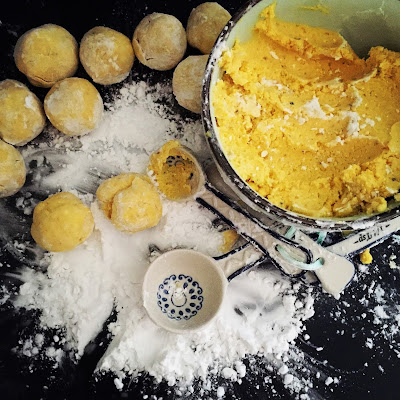Już dawno
nie robiłam leniwych pierogów. A chodzą za mną od jakiegoś czasu.
Kupiłam
ostatnio dynię o pięknym, żółtym kolorze. Upiekłam ją z czosnkiem i tymiankiem,
i część wykorzystałam do zrobienia tych pysznych pierożków.
Te pierogi
są bardzo delikatne, duża ilość twarogu i dyni sprawia, że są lekkie i puszyste
jak poduszeczki.
I havent’t been making gnudi for
quite some time but I have been entertaining the idea for a very long time
already. I was planning to make the gnudi, „a girl and her pig” style.
Last Thusrday I bought a beautifully
colored, yellow pumpkin on my farmer’s market. I roasted it right away with a purpose
of making some soup (which I actually made) and maybe using it to make some
other stuff.
And lo, it just snapped, pumpkin gnudi.
I am going to use the pumpkin to make the gnudi.
The delicate, beautifully colored, fluffy
and light gnudi. And what is most important gluten free gnudi.
Cooked and baked in sage butter they were a true treat! Now I
am thinking about making some other gnudi.
Enjoy!
20 pierogów z wielkości 3 cm
Składniki:
1 szklanka
upieczonej dyni
1 szklanka twarogu
1 jajko
1 szklanka
startego parmezanu
sól i pieprz
sól i pieprz
1/2 szklanki
mąki ziemniaczanej
2 łyżki
masła
garść listków
szałwii
parmezan do
posypania
Upieczoną
wcześniej dynię i twaróg przeciskamy przez praskę, dodajemy jajko i parmezan.
Doprawiamy masę pieprzem i solą i mieszamy wszystko dokładnie. Na koniec
delikatnie dodajemy do masy mąkę. Wkładamy masę pierogową do lodówki na 30
minut.
Nabieramy
ciasto wielkości łyżeczki i formujemy z niego kulki o średnicy ok.3 cm.
Obtaczamy kulki w mące ziemniaczanej.
Gotujemy
leniwe pierogi w mocno osolonej wodzie, na małym ogniu, aż wypłyną na wierzch.
Podczas gdy
leniwe się gotują, roztapiamy masło na patelni i podsmażamy w nim liście
szałwii.
Wykładamy
leniwe pierogi na talerz i polewamy je masłem i szałwią. Przed podaniem posypujemy
parmezanem.
20 gnudi of 1 inch size
Ingredients:
1 cup of roasted pumpkin
1 cup of cottage cheese
1 egg
1 cup of grated Parmesan cheese
salt and pepper
½ cup potato flour
4 tablespoons of butter
a handful of sage leaves
grated Parmesan for sprinkling
Pass the roasted pumpkin and
cottage cheese through the ricer. Transfer into a bowl, add the egg and grated Parmesan cheese.
Season with salt and pepper, add
the potato flour and mix everything thoroughly. Put the mass in the fridge for
30 minutes to rest.
Remove a heaping teaspoon of the batter from the bowl and form the
balls with a diameter of about 1 inch. Roll each ball in potato starch and put aside until you finish making the gnudi.
Cook the gnudi in heavily salted, barely simmering water, until they come up to the surface.
While the dumplings are cooking, in a pan with a metal handle melt the butter and
fry the sage leaves until crisp.
Transfer the drained gnudi to the pan, and toss them in butter, put the
pan in the oven and bake until they get crisp on the outside.
Season with salt and pepper and sprinkle with Parmesan cheese before serving.


























